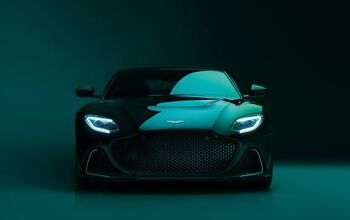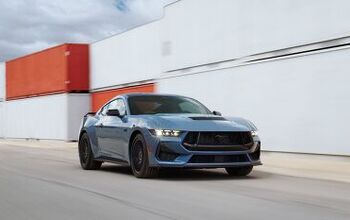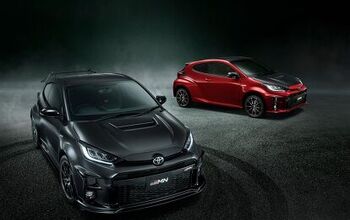The Early 1980s Are Back! GM Anticipates Big Demand for Diesels

Volkswagen’s emissions scandal may have killed that company’s diesel presence in North America, but it didn’t kill demand for diesel engines in general — especially ones that don’t pollute like Chernobyl and end up in the trash heap.
At least, that’s General Motors’ take on it. The automaker hopes to fill the void created by VW’s oil-burning absence and, in doing so, score some points with the EPA. With diesel engines now available in five vehicles you won’t see on a worksite (and five more that you would), GM has high hopes it can erase memories of its 1980s diesel woes.
This year, the automaker will offer its Europe-sourced and EPA-approved 1.6-liter turbodiesel in the 2017 Chevrolet Cruze and 2018 Equinox, as well as the similarly updated 2018 GMC Terrain. Already, a 2.8-liter four-pot diesel can be had in the Chevy Colorado/GMC Canyon twins.
The move isn’t just about offering customers more torque than the models’ base gas engine can muster. How would any automaker turn down an opportunity to advertise a non-hybrid sedan that gets 52 miles per gallon on the highway? The engine’s availability also boosts GM’s corporate average fuel economy, putting it in the EPA’s good books.
Speaking to The Detroit News, Dan Nicholson, GM’s vice president of global propulsion systems said the “outlook for diesel in the U.S.A. is actually promising.”
“We definitely see certain segments reaching 10 percent penetration and yes, an upside potential of 10 percent overall,” said, adding that 9 percent of Colorado and Canyon buyers opt for the diesel model.
“If we hit that number on Cruze, we’d be delighted. We’d be happy with a lower number than that. We need to test the market and see where things are going.”
Unlike the short-lived first-generation Cruze diesel, which was offered only in high-end trim with an automatic transmission, GM saw fit to move its successor downmarket and offer a manual. That stick shift’s tall upper ratios allows the Cruze TD to reach its lofty MPG figure. The automatic variant, even though a nine-speed, achieves only 47 mpg on the highway.
GM is crossing its fingers and hoping that its high-tech diesels erase some of the stigma oil-burning mills once attached to the automaker. Its V6 and V8 diesels, offered from 1978 to 1985, offered impressive fuel economy for the day, but proved disastrous in practice. Sluggish performance and breakdowns ultimately killed GM’s diesel passenger car gambit, leaving the field wide open for German rivals.
[Image: General Motors]

More by Steph Willems
Latest Car Reviews
Read moreLatest Product Reviews
Read moreRecent Comments
- SCE to AUX My son cross-shopped the RAV4 and Model Y, then bought the Y. To their surprise, they hated the RAV4.
- SCE to AUX I'm already driving the cheap EV (19 Ioniq EV).$30k MSRP in late 2018, $23k after subsidy at lease (no tax hassle)$549/year insurance$40 in electricity to drive 1000 miles/month66k miles, no range lossAffordable 16" tiresVirtually no maintenance expensesHyundai (for example) has dramatically cut prices on their EVs, so you can get a 361-mile Ioniq 6 in the high 30s right now.But ask me if I'd go to the Subaru brand if one was affordable, and the answer is no.
- David Murilee Martin, These Toyota Vans were absolute garbage. As the labor even basic service cost 400% as much as servicing a VW Vanagon or American minivan. A skilled Toyota tech would take about 2.5 hours just to change the air cleaner. Also they also broke often, as they overheated and warped the engine and boiled the automatic transmission...
- Marcr My wife and I mostly work from home (or use public transit), the kid is grown, and we no longer do road trips of more than 150 miles or so. Our one car mostly gets used for local errands and the occasional airport pickup. The first non-Tesla, non-Mini, non-Fiat, non-Kia/Hyundai, non-GM (I do have my biases) small fun-to-drive hatchback EV with 200+ mile range, instrument display behind the wheel where it belongs and actual knobs for oft-used functions for under $35K will get our money. What we really want is a proper 21st century equivalent of the original Honda Civic. The Volvo EX30 is close and may end up being the compromise choice.
- Mebgardner I test drove a 2023 2.5 Rav4 last year. I passed on it because it was a very noisy interior, and handled poorly on uneven pavement (filled potholes), which Tucson has many. Very little acoustic padding mean you talk loudly above 55 mph. The forums were also talking about how the roof leaks from not properly sealed roof rack holes, and door windows leaking into the lower door interior. I did not stick around to find out if all that was true. No talk about engine troubles though, this is new info to me.


































Comments
Join the conversation
I wonder if the EPA will introduce a different testing method for diesels.
Lazy writing. "GM" "Diesel" ... let's talk about the 1980s diesel fiasco. Interesting writing would have been to research the roots of GM's modern European sourced diesels, or perhaps to talk about what the divestiture of Opel might mean to the long term place of diesel technology in the GM portfolio. Or, look at the controversy in Europe about what place diesel has in the ongoing development of automobiles there. But no, just go for the quick hit of saying what everyone already knows about the 1980s diesel fiasco.